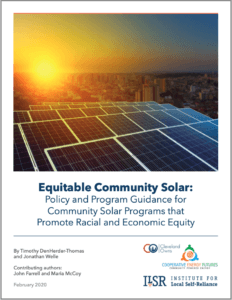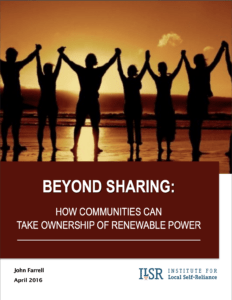New York enabled virtual net metering in 2011 for solar, wind, and farm-based biogas systems. Virtual Net Metering allows shared-ownership groups or neighborhoods to collectively receive credits for off-site renewable energy generation — essentially allowing community solar. The state did not establish a formal community solar program until 2015, when the New York Public Service Commission issued an order in Case 15-E-0082 establishing the Community Distributed Generation Program.
Through the Community Distributed Generation Program, also called the Shared Renewables Program, community members join together and partner with a project sponsor who builds and operates the solar generation facility. The New York State Energy Research & Development Association (NYSERDA) administers the Community Distributed Generation Program through NY-Sun. The program provides opportunities for renters, homeowners, low-income residents, schools, and businesses to access clean and affordable power. Shared renewables projects must have at least ten members and individuals cannot own over 25 kilowatts, or no more than 40% of the project’s output.
Community solar gardens may belong to the community collective, not the utility, meaning that ownership is flexible (one of ILSR’s four principles for community renewable energy). Credits for each solar generation facility are calculated using New York’s Value of Distributed Energy Resources tariff, which provides adders for various attributes. Because of these credits, community distributed generation has additional value and subscribers save money — giving participants tangible benefits (ILSR’s first principle for meaningful community renewable energy).
See New York’s program progress in our Community Solar Tracker.
REV-ving up Community Solar
In 2015, Governor Cuomo unveiled the “Reforming Energy Vision” (REV) initiative. REV is a broad initiative to transform New York’s energy sector and increase community participation in renewables. NY-Sun, the solar-focused arm within REV, includes various resources and incentives that support New York’s solar industry and make solar technology more affordable.
The Community Shared Renewables program falls under NY-Sun. Community Shared Renewables projects receive credits via the Value of Distributed Energy Resources tariff (the state calls this the Value Stack) and its Community Credit and Market Transition Credit components. When a community solar garden applies for interconnection, its Community Credit rate is locked in for 25 years.
NY-Sun allocated $13 million to build 3,000 megawatts of community solar projects in low- to moderate-income communities over the course of 10 years. Allocating carve-outs for historically marginalized customers aligns with ILSR’s fourth principle for community renewable energy: access for all. New York’s community solar program also increases overall solar, since community solar gardens earn special credits and do not compete with utility-scale solar, meeting ILSR’s third principle for successful community renewable energy.
The Community Shared Renewables program was rolled out in two phases, with phase one beginning on October 19, 2015. During phase one, community solar sponsors could only build projects in designated “opportunity zones,” or where at least 20% of residents are low- to moderate-income customers. Phase two began on May 1, 2016, with no restrictions.
Community Solarize
Across the nation, Solarize campaigns utilize community outreach and group negotiation to ensure affordable prices for individuals hoping to install rooftop solar. New York’s Solarize Your Community campaign uniquely helps those looking to subscribe to community solar, as well.
The New York State Energy Research & Development Association has supported Solarize since 2015. The state provides a map that shows active solarize campaigns, the number of participating projects within campaigns, their location, the energy capacity produced, and the cost per watt. NY-Sun provides additional Solarize materials, including a Solarize Guidebook, webinar, and campaign templates.
New York’s Solarize Your Community campaign has lost its steam in recent years; the last active campaign was in 2018. NYSERDA and NY-Sun supported Solarize through four rounds of funding starting in 2014, with the third round expanding support to community solar.
Community Solar Plus Storage
In September 2020, the state’s first community solar-plus-storage project was completed. It will generate 557 kilowatts of community rooftop solar and is paired with 490 kilowatts of energy storage, stored in a four-hour lithium-ion battery from Tesla Powerpack. The project will provide 150 households with power.
The New York State Public Service Commission established a credit adder for battery storage as part of a 2020 NY-Sun extension, which will further incentivize community solar-plus-storage.
Visualizing the Future
In 2019, NYSERDA requested that the New York State Public Service Commission allocate $573 million to expand the NY-Sun program and dedicate $135 million to LMI customers. Much of the community solar capacity set aside in 2015, including most of the Community Credits in NYSEG and National Grid territory, had already been allocated — hence the need for additional funding and a new community credit.
In May of 2020, the Commission petitioned to fully fund NY-Sun through 2025 and established a Community Adder to replace the Community Credit — though it will operate through a “declining block structure.” The extension also introduces new adders to the value stack: “adders for projects paired with storage, those that add resiliency or value for disadvantaged and affordable housing communities, and projects located on brownfields, landfills, and parking lots.”
Depending on the utility service territory, New York community solar developers can take advantage of either the original Community Credit, or, if there are no more credits, the new Community Adder. The state displays credit availability on the Community Adder dashboard. New York also offers funding for predevelopment and technical assistance to community solar developers hoping to serve either low- to moderate-income subscribers or affordable housing complexes.
In 2021, New York’s community solar program has 449 megawatts of generating power online, serves 14,000 subscribers, and has an additional 350 projects in development.
For more on solar in New York, check out these ILSR resources:
- New York Solar Bill Encourages Distributed Energy Market to Stay on Target (2018)
- New York City Should Meet Half Its Peak Demand with Rooftop Solar PV (2011)
- New York Just Showed Every Other State How to Do Solar Right (2015)
Learn more about community solar in one of these ILSR reports:
For podcasts, videos, and more, see ILSR’s community renewable energy archive.
This article was originally posted at ilsr.org. For timely updates, follow John Farrell on Twitter or get the Energy Democracy weekly update.
Featured photo credit: Ronovus Solar via Flickr. (CC BY 2.0)








